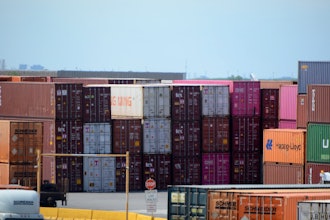HANGZHOU, China (AP) — Gravel-laden barges glide past the willow-fringed banks of the Grand Canal, plying a trade route built 2,500 years ago to bring grain from China's fertile south to its rulers in the north.
Now the 1,800-kilometer (1,125-mile) passage is part of an even grander scheme: a $150 billion plan to bring water from the mighty Yangtze river to the parched north in what is the world's most expensive infrastructure project.
Increasingly, a group of rising economies — from Brazil to the United Arab Emirates — is building the showcase projects that once were mainly the pride of the U.S., Western Europe and Japan. America's Hoover Dam made headlines in the 1930s; today, it is China's $25 billion Three Gorges Dam.
Just as railways and highways transformed America into an industrial superpower, the 21st-century building boom is laying the foundations for these rapidly growing economies to join the top leagues.
"Projects are getting bigger and bigger in the developing economies, not only to cater for demand, but also in anticipation of future growth," says Wilfred Lau, director at the engineering and design consultancy Ove Arup & Partners in Hong Kong.
Half of the 30 most expensive projects globally are in China, Brazil, the Middle East and other parts of the developing world, according to a list compiled by The Associated Press. A dozen are in the rich countries, and three others are energy pipelines that will link Western Europe with Russia and Turkey. The data comes from governments and companies involved in the various projects, and from AP archives.
Not all these projects will necessarily be completed, but cancellations would seem at least as likely among the cash-strapped governments of the West and Japan as anywhere else.
Topping the list is China's South-North Water Diversion plan, which would use the Grand Canal and two other routes to channel water to Beijing and other fast-growing northern cities. Alone, its price tag dwarfs the $65 billion for all five U.S. projects in the top 30.
Poor countries have always needed better roads, more electricity and other improvements, but few could afford them and many, like Haiti, still can't. Still, much has changed dramatically in the past two decades as global growth has shifted to countries such as China and Brazil.
The money flowing into their government coffers has enabled them to launch the major infrastructure projects that bring prestige, improve living standards and set the stage for the next level of economic development.
But there are limits: Such huge flows of wealth can be squandered on corruption or showcase projects that turn into white elephants. Some cite the $450 million stadium built for the 2008 Beijing Olympics as a case in point.
In China, India and elsewhere, subway, bridge and building collapses indicate that not all the construction is as solid as it should be. Ultimately, such investments need to be environmentally, socially and economically sustainable to pay off. And already some projects have been idled by the global financial crisis.
Big-ticket items aren't confined to the developing world. Britain's plan to spend 100 billion pounds ($132 billion) on offshore wind farms is the second priciest project on the list compiled by the AP, followed by Japan's 5 trillion yen ($62 billion) Daini Tomei Highway.
The $65 billion in U.S. projects includes a new $20 billion air traffic control system, which ranks 13th on the list, followed by separate $14 billion projects to upgrade flood barriers in New Orleans and build two nuclear power plants in the state of Georgia.
Overall, just 2 percent of the U.S. gross domestic product goes to infrastructure construction. Europe spends 5 percent of its GDP, and China, 9 percent, according to a U.S. government report.
Developing countries, led by China, are devoting $384 billion to the biggest dams, highways, railways, bridges, canals and energy projects. Brazil is building a 518-kilometer (320-mile) $18.4 billion high-speed train link from Rio de Janeiro to Sao Paulo and an $11.3 billion hydroelectric complex on the Madeira River, a major tributary of the Amazon.
One country where public works construction has lagged is India, which has only one project on the list, a $9.3 billion nuclear power plant deal it signed with France this month. Many economists see weak infrastructure has one of India's biggest handicaps — as well as a potential growth area for the world's construction industry.
Only one African project made the top 30, a 1,216-kilometer (750-mile), six-lane highway linking Algeria with Tunisia and Morocco and costing $11.2 billion. But even on the world's poorest continent, billions are going to new railways, roads, mines and public housing — often built with Chinese money as Beijing swaps financing and other aid for access to minerals, coal and oil.
The Boston Consulting Group says that more than half of the $40 trillion or so needed for infrastructure in the coming two decades is likely to be spent in the developing world.
In China, a 4 trillion yuan ($586 billion) stimulus package launched when the global financial crisis slowed exports is already bearing fruit. The Communist Party's routine suppression of public dissent means projects tend to get done — and quickly.
While U.S. states are talking about high-speed rail, China is set to double its network — already the world's longest — to 16,000 kilometers (10,000 miles) by 2020.
Inevitably, some see big drawbacks to the building boom. They worry that too much construction is unwieldy, resulting in schools or clinics that collapse, and that services such as old-age homes and firefighting equipment can't keep up with rapid urbanization.
Continued spending at the current pace is unsustainable, said Nicholas Lardy, a China expert at the Peterson Institute for International Economics, a Washington think tank.
"They're not building bridges to nowhere, but if they keep this up for a few more years they might be," he said.
Major projects also often extract an environmental toll.
The classic example is southern Egypt's Aswan Dam, completed in 1970, which generates much-needed electricity and controls flooding, but also prevents nutrient-rich sediment from replenishing the eroding Nile delta, the country's most productive farmland.
Some question whether China's water diversion project, due to be finished in 2050, is worth the risks.
The plans call for sending 45 trillion liters (12 trillion gallons) of water a year from the Yangtze to the north. Wang Weiluo, a Chinese hydrologist living in Germany, says cities such as Shanghai, which lies downstream from where the water will be diverted, will see their own water resources reduced.
It's not clear that southern China can spare that much water, especially with the glaciers that feed the Yangtze melting, said Kenneth Pomeranz, a China water expert at the University of California, Irvine.
But alternatives, such as hiking the price of water, are politically difficult, and much prestige is invested in seeing the project to completion, he said. "It may well be a bad idea whose time has come."


















